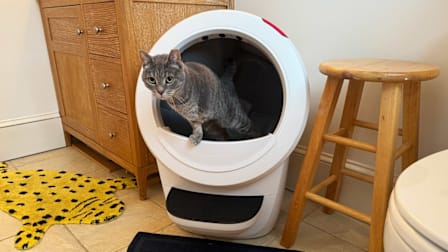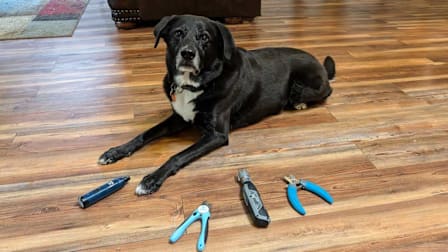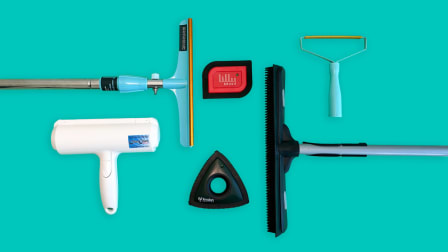7 Expert Tips to Help You Find the Right Cat Tree
Because your cat needs its own condo right meow!
When you shop through retailer links on our site, we may earn affiliate commissions. 100% of the fees we collect are used to support our nonprofit mission. Learn more.
When Consumer Reports shopping editor Mary Beth Quirk first brought home a cat tree for her calico-tabby mix, Frannie, her cat was “totally obsessed.” Frannie would “even groom the white, fluffy faux fur on it as if it was another animal,” Quirk says.
Cats are mysterious creatures with some unusual behaviors (see above), but cat owners are more straightforward: We love our feline friends and will go to great lengths to ensure that they’re comfortable. Experts say one way to make your cat happier is to invest in a cat tree.
Yes, Your Cat (Probably) Needs a Cat Tree. Here’s Why.
“All cats need access to important environmental resources, including food, water, litter boxes, rest and sleep areas, and elevated areas or perches” like those cat trees provide, says Michelle Meyer, DVM, associate veterinarian of Serenity Animal Hospital in Michigan and former president of the American Association of Feline Practitioners. “These are known as the five pillars of a healthy feline environment. Meeting your cat’s environmental needs can help to avoid stressors that could initiate unwanted behavioral or medical consequences.”
While experts say it’s possible to create an environment that will provide all of a cat’s needs without buying a cat tree, they are a convenient way to check a lot of boxes with a single product. “Cat trees provide a scratching surface to help with nail care. They also help your cat get a good stretch after naps by reaching their front feet up as high as they can and stretching,” says LeeAnna Buis, a certified feline training and behavior consultant. “And don’t forget scent! It’s arguably a cat’s most important sense. They use scratching surfaces like their cat tree to leave their scent and communicate with other cats in the home. I’d suggest every cat parent have a cat tree or other acceptable ways for their cats to scratch, stretch, climb, and perch up high.”
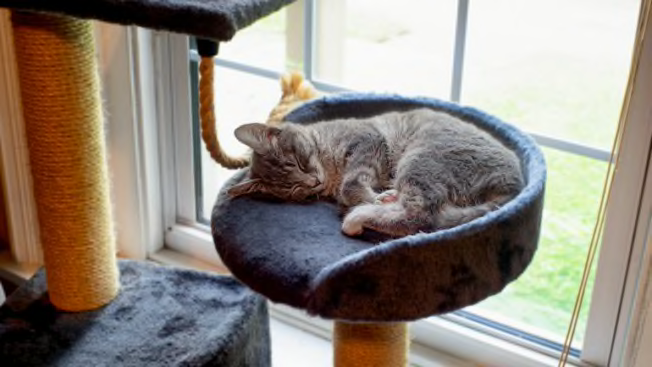
Photo: Getty Images Photo: Getty Images
Buis says that when considering a cat tree, it’s important to remember that cats are individuals. “You definitely want to take their likes and dislikes into account, not to mention their size and any medical considerations that might mean they can’t or shouldn’t jump and climb.” Keeping the following points in mind when shopping for a cat tree will help you find one best suited to your pet.
Your Guide to the Best Pet Products
Consider Cubbies
Does your cat like to sit in every empty box and other close spaces? If so, look for a tree that has a lot of cozy cubbies for your kitty. If your cat is a climber, look for a tree with lots of platforms and high vantage points.
“Cats are curious by nature,” says Jane Brunt, DVM, a veterinarian and executive director of the nonprofit CATalyst Council. “And what’s more interesting than a new box? Just as cats like to be high in some circumstances, many also like to feel hidden and feel safer when they can get inside, yet still have an escape route.”
Cat Trees With Cubbies
Frisco 62" Modern Cat Tree, $112 at Chewy
Modern Jute Cat Tree & Condo, from $49 at Chewy, Petco, Petsmart, Wayfair
Find Your Cat's Preferred Textures
Cats also like to scratch different textures—some prefer corrugated cardboard, while others like jute, seagrass, or sisal (rope). Before you buy a cat tree, try to find out which texture your cat prefers—many pet stores sell small scratchers you can buy to let your kitty try out before selecting a larger one.
Know the Direction Your Cat Likes to Scratch
Some cats are horizontal scratchers while others scratch vertically. Once you know which direction your cat likes to scratch and which texture is most appealing to them, you can look for a cat tree that offers what your cat prefers. If you have a horizontal scratcher, look for a base in that texture, and if you have a vertical scratcher, look for a “tree trunk” with the right texture.
Cat Tree for Mostly Vertical Scratchers
Archie & Oscar 49" Dexter Contemporary Cat Tree, from $199 at Amazon, Petsmart, Petco, Wayfair
Cat Tunnel for Mostly Horizontal Scratchers
Imperial Cat Tower Tunnel Scratch ’n Shape, from $50 at Amazon
Size Up Your Cat
If you have a large cat, meaning one weighing over 10 pounds, you want to be sure that the tree you purchase is sturdy enough to support it. Look for a tree with a wider, heavier base that won’t tip when your cat jumps up. It’s also a good idea to buy one with larger platforms that can accommodate your pet’s size.
Cat Trees for Large Cats
Feandrea Cat Tree For Large Cats, from $70 at Amazon
Hey-Brother Cat Tree, from $90 at Amazon
Find an Age-Appropriate Cat Tree
If you have an older cat, jumping might not be easy—many felines get arthritis in their old age. Cats are considered “senior” at 10 years old.
“A younger cat would probably enjoy just about any style of cat tree,” Buis says. “But an older cat might need something with more or larger platforms so it’s easier to climb up.” You might also want to move the tree to a new spot as your cat ages. “Maybe you put the cat tree near the couch so they can hop up on the couch seat first, then the arm, make their way to the back and more easily get up higher on the cat tree,” Buis says.
On the other hand, if you have a younger, more active cat, you may want a cat tree with more activities—like hanging balls, feathers, or bells for your cat to play with. You can find a tree with toys already installed or add them yourself.
Cat Tree for Older Cats
Frisco 33" Faux Fur Cat Tree and Condo, from $45 at Chewy
Cat Tree for Younger, or More Active, Cats
Fur Haven Tiger Tough Interactive Cat Tree Tower from $120 at Amazon, Chewy, Walmart
The Advantages of Two Trees
“If you have the space, I’d recommend more than one cat tree, even in single-cat households,” Buis says. “For two-cat households, a second cat tree may be even more important. Multiple cats can and will share a cat tree if they’re comfortable doing so, but it’s always a good idea to have more than one of any key resource like climbing, scratching, and resting spots.”
Cat Trees Big Enough for More Than One Cat
SHA CERLIN 65in Larger Cat Tree Tower Condo, $99
Go Pet Club 62" Cat Tree, $73
Find the Right Spot for Your Cat Tree
Kari Whitman, an interior designer at Kari Whitman Interiors—a firm with a focus on pet-friendly spaces—says that it’s important for cat owners to integrate the cat tree into their living space. “Animals should be part of the home, not segregated in a room or outside,” she says. “They’re part of the family, so it’s just as important to create a home environment that’s welcoming to pets as well.”
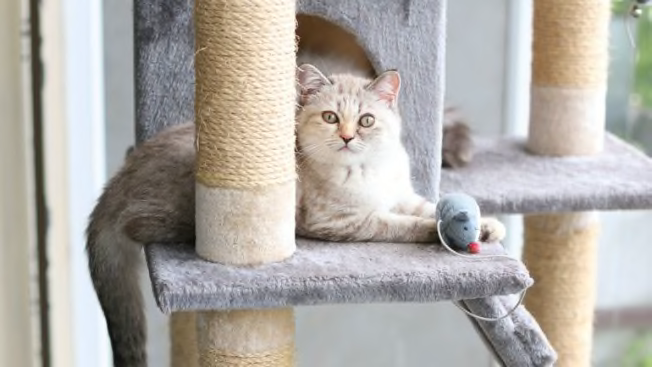
Photo: Getty Images Photo: Getty Images
“Put your cat tree against the wall, but near a window,” Whitman says. “Cats like to have something solid behind them—it makes them feel safe. But they also love looking outdoors. Give them a perch from where they can observe the birds in your yard.”
To make your cat tree a little easier on the (human) eye, Whitman suggests covering the platforms with faux fur. This will also give your kitty a soft surface on which to sleep.
As for Quirk’s cat, Frannie? “I’ve had the cat tree for a few months now,” she says, “So she goes through phases where it’s the only place she wants to hang out, and others where she completely ignores it.”
Oh, how very catlike.

















